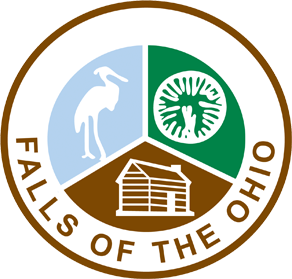The Rotunda is dominated by a giant mural showing an aerial view of the Falls of the Ohio from about 1600, before human-made changes were made to the river. The admissions desk is at your left, as is the gift shop, and the hall to the restrooms. To your right is a cast of a Columbian mammoth that leads to the auditorium and exhibits. Look up and you will see hand-blown glass sculptures suspended from the ceiling created by local glass artisan Brook White. Above the sculptures you will see cycloramic banners introducing the Center’s four exhibits.
Rotunda Sculpture Interpretation
An Ancient Sea is a delicately balanced sculpture that creates the appearance of fossils floating in space. There are nine etch- glass platters, backlit in blue and amber hanging from three glass “waves” on metal rods. These represent fossils seen on the fossil bed today: a snail, trilobite, crinoid, brachiopod, bryozoan, horn coral, wasp nest coral, branching coral, and pipe organ coral.
A Changing Land illustrates the progression of time on glass platters attached to an aluminum tree branch of life introduces this exhibit. The sculpture progresses from barren earth, to mammoth tracks, to bison hoof prints, the emergence of human foot prints, and the dawning of a lush landscape with colorful wildflowers.
Converging Cultures is symbolized by a common mode of river transportation for both past and present cultures – the canoe. On both sides of the canoe, engraved in red and yellow glass are sun circle designs of the Mississippian Period’s prehistoric native people living along the Ohio River 1,000-500 years ago. Modern culture is portrayed in black and white glass etched with a towboat and city skyline. Blue glass conveys the connecting theme of water.
The Falls Today is illuminated by the cascading waterfall centerpiece which exemplifies the Falls or rapids with blue glass water droplets. The arc of time with sun, moon, and stars stretches across the centerpiece. The sun’s power is manifested in tri-colored glass rays bursting outward with energy. The moon is composed of glass platters characterizing a gray, rocky landscape.
